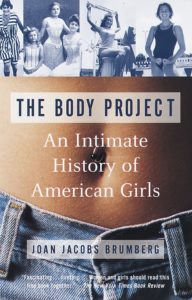 Thursday, March 28, at 6pm, a reading and book signing with Joan Jacobs Brumberg, author of FASTING GIRLS & THE BODY PROJECT. Join us for a fascinating and timely discussion about women, girls, body image and social change.
Thursday, March 28, at 6pm, a reading and book signing with Joan Jacobs Brumberg, author of FASTING GIRLS & THE BODY PROJECT. Join us for a fascinating and timely discussion about women, girls, body image and social change.
Joan Jacobs Brumberg is the award-winning author of FASTING GIRLS: THE HISTORY OF ANOREXIA NERVOSA and THE BODY PROJECT. She is a Stephen H. Weiss Professor at Cornell University, where she holds a unique appointment teaching in the fields of history, human development, and women’s studies. Her research and sensitive writing about American women and girls have been recognized by the Guggenheim Foundation, the National Endowment for the Humanities, the Rockefeller Foundation, and the MacDowell Colony.
 Winner of four major awards, the updated edition of Joan Jacobs Brumberg’s FASTING GIRLS, presents a history of women’s food-refusal dating back as far as the sixteenth century. Here is a tableau of female self-denial: medieval martyrs who used starvation to demonstrate religious devotion, “wonders of science” whose families capitalized on their ability to survive on flower petals and air, silent screen stars whose strict “slimming” regimens inspired a generation. Here, too, is a fascinating look at how the cultural ramifications of the Industrial Revolution produced a disorder that continues to render privileged young women helpless. Incisive, compassionate, illuminating, FASTING GIRLS offers real understanding to victims and their families, clinicians, and all women who are interested in the origins and future of this complex, modern and characteristically female disease.
Winner of four major awards, the updated edition of Joan Jacobs Brumberg’s FASTING GIRLS, presents a history of women’s food-refusal dating back as far as the sixteenth century. Here is a tableau of female self-denial: medieval martyrs who used starvation to demonstrate religious devotion, “wonders of science” whose families capitalized on their ability to survive on flower petals and air, silent screen stars whose strict “slimming” regimens inspired a generation. Here, too, is a fascinating look at how the cultural ramifications of the Industrial Revolution produced a disorder that continues to render privileged young women helpless. Incisive, compassionate, illuminating, FASTING GIRLS offers real understanding to victims and their families, clinicians, and all women who are interested in the origins and future of this complex, modern and characteristically female disease.
 A hundred years ago, women were lacing themselves into corsets and teaching their daughters to do the same. The ideal of the day, however, was inner beauty: a focus on good deeds and a pure heart. Today American women have more social choices and personal freedom than ever before. But fifty-three percent of our girls are dissatisfied with their bodies by the age of thirteen, and many begin a pattern of weight obsession and dieting as early as eight or nine. Why?
A hundred years ago, women were lacing themselves into corsets and teaching their daughters to do the same. The ideal of the day, however, was inner beauty: a focus on good deeds and a pure heart. Today American women have more social choices and personal freedom than ever before. But fifty-three percent of our girls are dissatisfied with their bodies by the age of thirteen, and many begin a pattern of weight obsession and dieting as early as eight or nine. Why?
In THE BODY PROJECT, Brumberg answers this question, drawing on diary excerpts and media images from 1830 to the present. Tracing girls’ attitudes toward topics ranging from breast size and menstruation to hair, clothing, and cosmetics, she exposes the shift from the Victorian concern with character to our modern focus on outward appearance—in particular, the desire to be model-thin and sexy. Compassionate, insightful, and gracefully written, THE BODY PROJECT explores the gains and losses adolescent girls have inherited since they shed the corset and the ideal of virginity for a new world of sexual freedom and consumerism—a world in which the body is their primary project.
